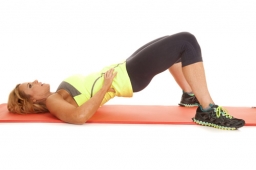Hip flexors – why they shouldn’t be overlooked.
Wednesday, October 29, 2014 - 13:20

Every athlete can benefit from strong hip flexors; however hip flexor strengthening is very seldom included in athletic training regimens. The hip flexors are the group of muscles that allow you to lift your knees toward your chest or bend forward from the hips. They play an important role in stabilizing the body and having weak, tight or unbalanced muscles in the hip area can negatively affect the lower back, hip, knee and ankle and undermine your overall athletic performance. Even in the athletic community where there is more of a need for work on the hip flexors, the muscles still tend to get overlooked.
Conditioning your hip muscles can be done with a wide range of exercises, many of which are available to learn through a physical therapist or sport trainer. While many of the exercises can be performed at home, it’s important to learn proper form from a trained professional before starting any strengthening program to prevent injury and ensure that you getting the most out of your training.
Why should you condition your hip flexors?
- The stronger the hip flexors, (along with the hamstrings and glutes), the faster an athlete is going to be.
- Well-conditioned hip flexors enable a faster and more powerful forward leg movement and upward knee drive.
- A lot of stress is put on the hip flexors when an athlete sprints or kicks, that’s why athletes, especially those that participate in football, ice skating, soccer, basketball, powerlifting, martial arts, and sprinting are especially prone to hip flexor injuries.
- Scientific evidence exists that connects poor strength and coordination in the hip stabilizer muscles to IT band syndrome and patellofemoral pain syndrome or “runner’s knee”; injuries that are common for athletes.
When performing any hip strengthening exercises, be sure to maintain the correct form and increase the amount of repetitions slow to allow your body to adapt. Keep all movement controlled and within small ranges until you feel equipped to increase movement without sacrificing quality.
Below are a couple of exercises you can perform:
Glute bridge: Lie with your back on the floor and knees bent at 90 degrees. Lift the hips off the floor by pushing through the floor with your heels. The result should be a bridge from the back of your shoulders to your knees. Lower your hips and repeat.
Single or double leg squats: Have your feet slightly apart in front of your body with your toes facing forward and bend your knees, sinking down towards the ground. As you sit back, lean your chest forward to counterbalance the weight of your hips. Once you reach a level at which your thighs are parallel to the ground, stop lowering your body. Most of your weight should be balanced between your heel and the ball of your foot, not out on the toes. When doing single leg squats, keep your hips square and level at all times. If your outer hip muscles are weak, the non-supporting hip will drop or rotate in.
With a muscle group that is so involved in everyday activity, it seems pretty important that we take care of them. The better the overall hip mobility, the more athletic ability you will have in general. Athletes that participate in sports that require quick or deep hip movements like running, kicking or squatting, for example will benefit the most from conditioning the hip flexors and will quickly notice dramatically improved performance.
References from the SIRC Collection:
1. DE MARCHE BALDON R, SERRÃO F, SILVA R, PIVA S. Effects of Functional Stabilization Training on Pain, Function, and Lower Extremity Biomechanics in Women With Patellofemoral Pain: A Randomized Clinical Trial. Journal Of Orthopaedic & Sports Physical Therapy. April 2014;44(4):240-251.
2. Lorenz D. A Multi-Plane Hip Flexor Stretch. Strength & Conditioning Journal (Allen Press). April 2007;29(2):68-70.
3. McBeth J, Earl-Boehm J, Cobb S, Huddleston W. Hip Muscle Activity During 3 Side-Lying Hip-Strengthening Exercises in Distance Runners. Journal Of Athletic Training (National Athletic Trainers' Association). January 2012;47(1):15-23.
4. Stearns K, Powers C. Improvements in Hip Muscle Performance Result in Increased Use of the Hip Extensors and Abductors During a Landing Task. American Journal Of Sports Medicine. March 2014;42(3):602-609.
5. Tsiokanos A, Kellis E, Jamurtas A, Kellis S. The relationship between jumping performance and isokinetic strength of hip and knee extensors and ankle plantar flexors. Isokinetics & Exercise Science. June 2002;10(2):107.